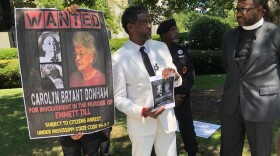There was a time when lynchings were treated like a parade through town or a big community event. Some were even commemorated on picture postcards and mailed to friends and family around the country.
Filmmaker Jacqueline Olive became fascinated by these old postcards and the stories of the nameless people strung up to their death. To Olive, they did not look much different than members of her family, and the images haunted her: Who were the spectators who gathered, laughed, and reveled at the sight of a public murder? These questions led Olive on a 10 year quest to document lynchings throughout the country. And she discovered that while many want to think of lynchings as a thing of the past, they continue on today. ÔÇťÔÇŁ centers around the suspected lynching of Lennon Lacy, a 17-year old African-American man who was found hanging from a swing set in Bladenboro, North Carolina in 2014. The death was ruled a suicide, but the victimÔÇÖs mother insists there was foul play. Filmmaker Jacqueline Olive joins host Frank Stasio to share ÔÇťAlways in SeasonÔÇŁ which won Special Jury Award for Moral Urgency at Sundance. The film will screen at the upcoming in Durham on Friday, April 5 at 7:20 p.m.
INTERVIEW HIGHLIGHTS
On the that inspired her documentary:
[ItÔÇÖs] a collection of photographs and images of lynching victims, of black people hanging surrounded by the smiling faces of white men, women and children. Through a certain period [until] about the 1930s or 1940s lynching was a spectacle event. Men, women and children would come out to watch a lynching as an event ÔÇŽ [A] photographer would set up right in the middle of the lynching, adjust the lighting for composition and photograph the violence as it happened. And people would also come up and pose with the bodies ÔÇŽ Those photographs were often turned into postcards.
On discovering the story of Lennon Lacy:
I filmed for four or five years, and I saw in the media that Lennon [Lacy] was found hanging in Bladenboro, North Carolina. He was found hanging from a swingset on August 29, 2014. And I reached out to his mother, Claudia, and spoke with his older brother Pierre to get more details. And the more that I talked to them the more that I realized there were so many parallels to what had been going on historically.
On the inconsistencies in the Lennon Lacy case:
One of the inconsistencies is they believe the shoes that were found on LennonÔÇÖs feet were not his. They were a size 10 ┬Ż, and Lennon wore a size 12. ThereÔÇÖs inconsistencies in the evidence. ThereÔÇÖs the fact that he was dating a ÔÇö at the time ÔÇö 31-year-old white woman in a town with sharp racial divisions.
On the way local law enforcement investigated Lennon LacyÔÇÖs death:
Like lynchings historically, there was a very swift investigation. [It was] very cursory. Within three days the police came to Claudia and Pierre and told them Lennon committed suicide. And Claudia did not believe her son committed suicide. She doesnÔÇÖt know what happened, but she wants answers.
On the discovery of recent hangings that may have been lynchings:
Ultimately the FBI did open an investigation into the case. ThatÔÇÖs actually quite unusual in the context of the speight of hangings that have been going on since 2005 ÔÇö of black people found hanging contemporarily in public places ÔÇŽ Heather Rattelade is the attorney who helped to bring the evidence to the FBI for the Lacy family. Heather found that there were 20 similar hangings of black people across the country from 2005 to 2016. And it's still continuing ÔÇŽ These cases are frequently swept under the rug, called a suicide with very little investigation.









